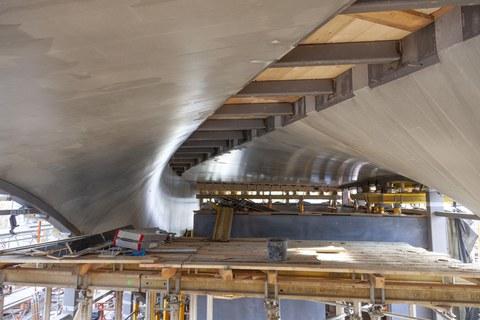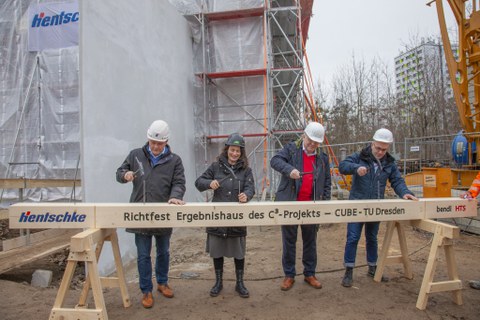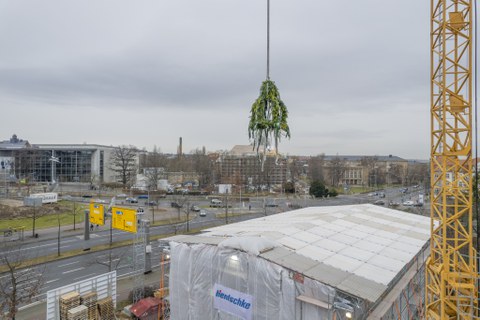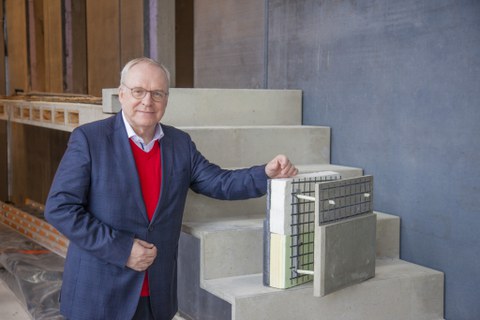Feb 03, 2022
CUBE topping-out ceremony – shell of the carbon reinforced concrete building is completed

TWIST shells, serving simultaneously as a wall and roof structure.
Construction commissioner Manfred Curbach calls it “a masterpiece of construction”
The topping-out ceremony for the CUBE, the world’s first building to use exclusively non-metallic reinforcement made primarily of carbon, was celebrated today on the TU Dresden campus. The construction was commissioned by Prof. Manfred Curbach, Chair of Concrete Structures at the TU Dresden and Chairman of the Board of the C³ – Carbon Concrete Composite association. The BMBF-funded C³ consortium is researching and developing a completely new type of construction using carbon concrete as a composite material. The CUBE is a milestone for broad application in practice.

Symbolisches Einschlagen der Zimmermannsnägel zum Richtfest (v.l.n.r.): Jens Kretzschmar, Marén Kupke, Manfred Curbach, Ludwig Pickert.
“Carbon reinforced concrete is not only the new ‘concrete without side effects;’ it also opens up opportunities for new, freer forms and can give construction new momentum,” says star architect Gunter Henn, referencing the initial project plan of a cuboid-shaped building. This cuboid BOX was ultimately expanded to include two TWIST shells, which simultaneously serve as a wall and roof structure. This is an extraordinary symbiosis of two elements. The walls of the BOX, which were produced in a prefabrication plant, exemplify the structure’s economic efficiency while the TWIST shells illustrate that carbon reinforced concrete can be shaped almost limitlessly into any shape. What started as an idea freed from feasibility and other constraints will soon result in a completed building at the corner of Zellescher Weg/Einsteinstraße. The next step includes the installation of the glass façades and building services as well as interior work. These activities, the design of the outdoor area and the furnishing of the building are set to be completed by the summer. Building inauguration is planned for September 2022.

The topping-out ceremony crown is hovering over the construction site at the corner of Zellescher Weg/Einsteinstraße
Hentschke Bau GmbH was responsible for the challenging and very complex construction of the TWIST. “With the CUBE, we have laid the foundation for a new construction method of the future. In doing so, we pushed the limits of what is possible with carbon reinforced concrete. The building represents a milestone in the history of construction and is a wonderful example of how carbon reinforced concrete can be used to make many new challenging projects possible,” says project manager Jens Kretzschmar. Bendl Hoch- und Tiefbau GmbH & Co. KG Sebnitz was responsible for the construction of the BOX. “The BOX proves that an economic construction method with innovative carbon reinforced concrete that is suited to the masses is already possible. With these automated production processes, we can pave the way to widespread use,” says Ludwig Pickert.

The construction commissioner Prof. Manfred Curbach shows how carbon concrete works on a model.
Construction commissioner Professor Manfred Curbach thanked the construction workers for their tireless commitment and for their willingness to work with a completely new material – carbon reinforced concrete. “The result speaks for itself. The employees of Hentschke Bau and Bendl HTS have created a construction masterpiece. They rose to the challenge of using as yet unregulated, newly developed building products to create an aesthetically sophisticated combination prefabricated and in-situ concrete structure using little-tried, ambitious construction techniques. Through their great expertise, craftsmanship and pronounced innovative strength, they breathed life into the carbon reinforced concrete construction method.” Marén Kupke, the architect responsible for the general planning at AIB – Architekten Ingenieure Bautzen, also expressed her satisfaction, stating, “We took on the challenge with enthusiasm and I am very pleased to see the completely new carbon reinforced concrete building we developed realized in such high quality. This was only possible thanks to the great cooperation between the planners involved, the construction commissioner and the contracted companies.” Foreman Heiko Panzner from Hentschke Bau says, “It was an exciting journey and a challenge at the same time. We began expanding our knowledge right from the beginning during the millimeter-precise production of the spatially curved formwork for the TWIST, and this learning process continued throughout. The installation and processing of the sprayed concrete also called for novel ideas and arduous techniques at every step of the work, but we were able to master them perfectly. We are very pleased with the result and proud of our part in it.”
Institute of Concrete Structures at TU Dresden: https://tu-dresden.de/bu/bauingenieurwesen/imb?set_language=en
C³ – Carbon Concrete Composite Association: https://www.bauen-neu-denken.de/en/homepage
